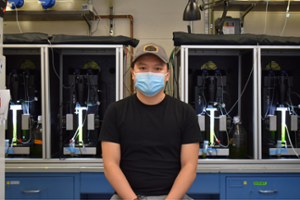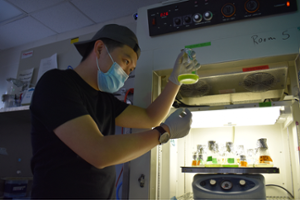Flip the switch: Looking at how algae activate cell cycles
Michigan State University researchers in the Christoph Benning lab at the MSU-DOE Plant Research Laboratory have been looking into the signals for activating different states of the cell cycle in microalga, which has potential applications for future biofuel production and cancer research.
The study was recently published in the journal G3: Genes, Genomes, Genetics.

Algal cells have two main cell cycles states: the cell division cycle and a resting state known as quiescence. Theoretically, the cells switch between the two states to adapt to their environment. For example, when nutrients are readily available, the algae enter the cell division cycle and use said nutrients to grow and multiply. When nutrients are limited, the algae enter quiescence to keep from using all their energy.
When switching between the two states, the cell goes through changes at both the metabolic and gene level. Genes within the cell will switch on and off to control which cell cycle state it is in. These genes are like a light switch for the cell division cycle – when the switch is on, the cell is working to grow and multiply. When it’s off, the cell rests.
The researchers are looking at how the microalga Chlamydomonas reinhardtii switches into different cell states by altering this gene expression.
The study focuses on a cell cycle regulator in the microalga called CHT7. The researchers saw the mutant strain, named cht7, that was lacking this regulator was unable to enter and exit quiescence properly. There was nothing to completely turn the switch on and off. The researchers grew the cht7 mutant cell in a photobioreactor and further analyzed it using RNA-sequencing to better understand why this was.

“We found the cht7 mutant cell has abnormally active DNA replication throughout its life cycle,” said Yang-Tsung Lin, a graduate student in the Benning lab and first author of the study. “Normally, an algal cell only duplicates its DNA for cell division at certain times during the day. However, the cht7 cells seem unable to turn down the expression of genes for DNA replication and mitosis, which leads to higher DNA content and abnormal cell shapes in the mutant.”
The CHT7 protein therefore seems to be the one to flip the switch, signaling the cell to enter or exit quiescence.
“Tsung’s data suggest the existence of a master regulator of the cell cycle and cell division,” said Barbara Sears, Professor Emerita of Plant Biology and co-author of the study. “His meticulous investigation identified a massive number of genes that are under the control of the CHT7 gene and are essential to DNA replication, chromosome organization, division of both chloroplasts and cells and genes needed for cell wall synthesis.”
This study has implications for future biofuel production and cancer research.

“We originally embarked on this study in algae to understand how the metabolic status of the cell affects growth versus the accumulation of useful compounds such as oils that can serve as feedstocks for biofuels,” said Christoph Benning, PRL director and senior author of the study.
“Proteins similar to CHT7 can even be found in humans, where disruption of cell cycle control can lead to cancer,” added Benning, a University Distinguished Professor in the Departments of Biochemistry and Molecular Biology and Plant Biology in the MSU College of Natural Science. “Hence finding key players involved in the regulation of the cell cycle has implications ranging from the production of algal feed stocks to addressing cancer in humans.”
Funding for this research was primarily provided by the National Science Foundation. Additional funding was provided by MSU AgBioResearch; the Chemical Sciences, Geoscience and Biosciences Division, Office of Basic Energy Sciences, Office of Science, U.S. Department of Energy; and the National Institutes of Health.
Banner image: Michigan State University researchers in the Christoph Benning lab at the MSU-DOE Plant Research Laboratory have been looking into the signals for activating different states of the cell cycle in microalga, which has potential applications for future biofuel production and cancer research. MSU graduate student, Yang-Tsung Lin (pictured above) is first author on the study, which was recently published in the journal G3: Genes, Genomes, Genetics.